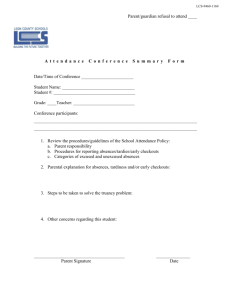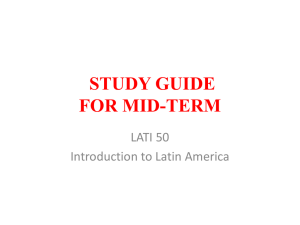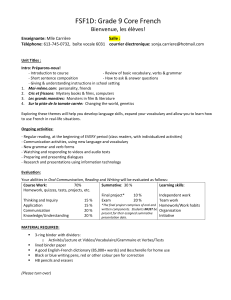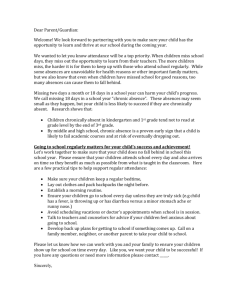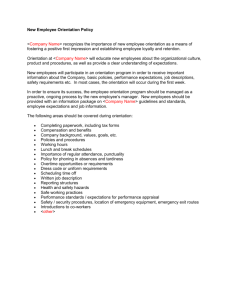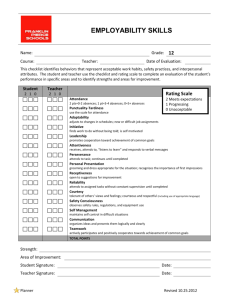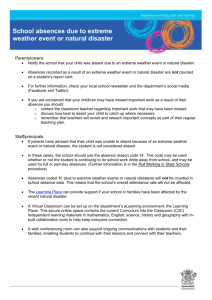comp abs tcpp
advertisement
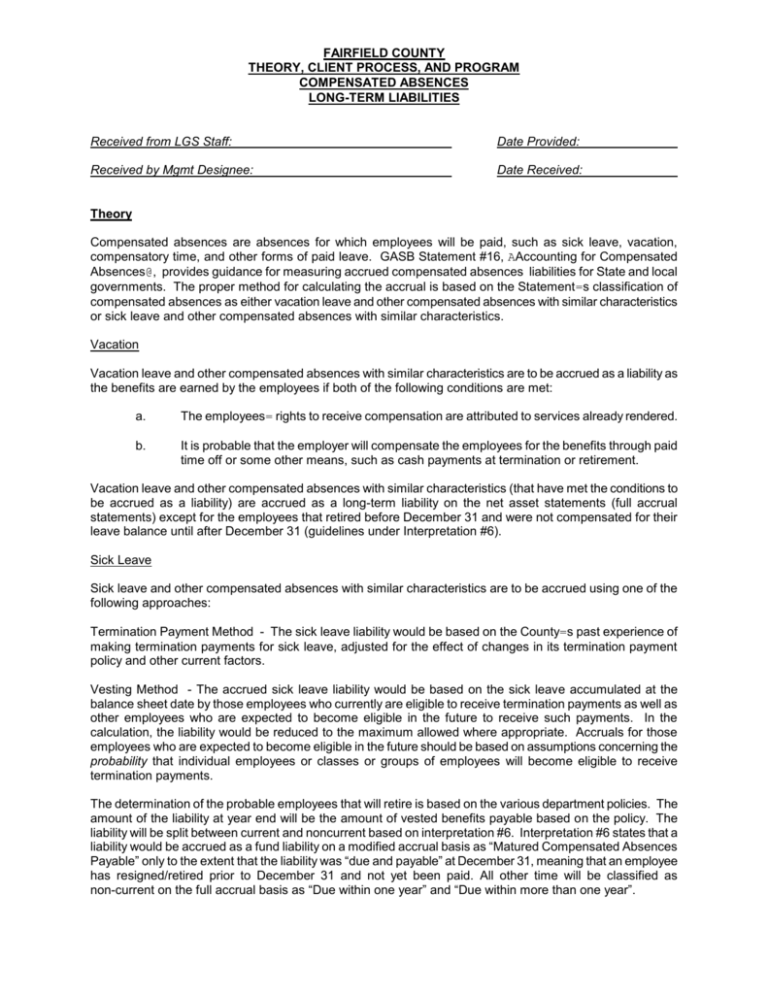
FAIRFIELD COUNTY THEORY, CLIENT PROCESS, AND PROGRAM COMPENSATED ABSENCES LONG-TERM LIABILITIES Received from LGS Staff: Date Provided: Received by Mgmt Designee: Date Received: Theory Compensated absences are absences for which employees will be paid, such as sick leave, vacation, compensatory time, and other forms of paid leave. GASB Statement #16, AAccounting for Compensated Absences@, provides guidance for measuring accrued compensated absences liabilities for State and local governments. The proper method for calculating the accrual is based on the Statement=s classification of compensated absences as either vacation leave and other compensated absences with similar characteristics or sick leave and other compensated absences with similar characteristics. Vacation Vacation leave and other compensated absences with similar characteristics are to be accrued as a liability as the benefits are earned by the employees if both of the following conditions are met: a. The employees= rights to receive compensation are attributed to services already rendered. b. It is probable that the employer will compensate the employees for the benefits through paid time off or some other means, such as cash payments at termination or retirement. Vacation leave and other compensated absences with similar characteristics (that have met the conditions to be accrued as a liability) are accrued as a long-term liability on the net asset statements (full accrual statements) except for the employees that retired before December 31 and were not compensated for their leave balance until after December 31 (guidelines under Interpretation #6). Sick Leave Sick leave and other compensated absences with similar characteristics are to be accrued using one of the following approaches: Termination Payment Method - The sick leave liability would be based on the County=s past experience of making termination payments for sick leave, adjusted for the effect of changes in its termination payment policy and other current factors. Vesting Method - The accrued sick leave liability would be based on the sick leave accumulated at the balance sheet date by those employees who currently are eligible to receive termination payments as well as other employees who are expected to become eligible in the future to receive such payments. In the calculation, the liability would be reduced to the maximum allowed where appropriate. Accruals for those employees who are expected to become eligible in the future should be based on assumptions concerning the probability that individual employees or classes or groups of employees will become eligible to receive termination payments. The determination of the probable employees that will retire is based on the various department policies. The amount of the liability at year end will be the amount of vested benefits payable based on the policy. The liability will be split between current and noncurrent based on interpretation #6. Interpretation #6 states that a liability would be accrued as a fund liability on a modified accrual basis as “Matured Compensated Absences Payable” only to the extent that the liability was “due and payable” at December 31, meaning that an employee has resigned/retired prior to December 31 and not yet been paid. All other time will be classified as non-current on the full accrual basis as “Due within one year” and “Due within more than one year”. FAIRFIELD COUNTY THEORY, CLIENT PROCESS, AND PROGRAM COMPENSATED ABSENCES LONG-TERM LIABILITIES County’s Method GASB Statement No. 16, "Accounting for Compensated Absences" specifies the methods used to accrue liabilities for leave benefits. Vacation and personal leave benefits are accrued as a liability as the benefits are earned if the employees' rights to receive compensation are attributable to services already rendered and it is probable that the employer will compensate employees for the benefits through paid time off or some other means. Sick leave benefits are accrued using the vesting method. The liability is based on the sick leave accumulated at December 31 by those employees who are currently eligible to receive termination payments and by those employees for whom it is probable they will become eligible to receive termination benefits in the future. The probable policy set by the County is reviewed every three years to determine that the years of service for the vesting method is appropriate. The vesting method was chosen by the County several years ago over the termination method. For governmental funds, the County records a liability for accumulated unused vacation time and personal leave when earned for all employees with more than one year of service. The current portion of unpaid compensated absences is the amount expected to be paid using expendable available resources. These amounts are recorded in the account "compensated absences payable' in the fund from which the employees who have accumulated unpaid leave are paid on the modified accrual statements. The remainder is reported on the net asset statements (full accrual statements). In proprietary funds, compensated absences are expensed when earned, and the entire amount of compensated absences is reported as a fund liability on the net asset statements. The County Commissioners' current policy is that all employees shall accrue sick leave at the rate of four and six tenth hours for each eighty hours of service. The County Commissioners= policy is that 25 percent of accrued unpaid sick leave, not to exceed 30 days, will be paid to an employee upon retirement or resignation if the employee has at least five years of total public service. Retirement means retiring under the Public Employees Retirement System (PERS). The qualifications are: An employee can qualify to retire with: 30 years of service and any age 25 years of service and 55 years of age 5 years of service at 60 years of age There are teachers at the Mental Retardation and Developmental Disabilities school that will retire under the State Teachers Retirement System (STRS) and the qualifications for their retirement are the same as under PERS. Vacation leave is earned by County employees after completing their first year of service. The employees accrue vacation hours each payday based on the following: YEARS SERVICE After 1 year After 8 years After 15 years After 25 years ANNUAL LEAVE 2 weeks (80 hours) 3 weeks (120 hours) 4 weeks (160 hours) 5 weeks (200 hours) Vacation time is to be used in the year in which it is accrued, before the employees' anniversary date. In special meritious cases, employees are allowed to carry over their vacation time, although no vacation time is to be carried over for more than three years. FAIRFIELD COUNTY THEORY, CLIENT PROCESS, AND PROGRAM COMPENSATED ABSENCES LONG-TERM LIABILITIES It is the policy of the County to pay employees 100% of earned, unused vacation hours at the time of separation after one year of service. Separation includes retirement, resignation and/or termination. All vacation earned must be included in the calculation of vacation leave costs. Compensatory time is the amount of time worked over ' and above the 40 hour work week and accumulated at one and one-half times the number of hours worked. Maximum accruals is set at 480 hours for employees classified under public safety, and 240 hours for all other employees. Compensatory time must be used within 180 days of its accrual. Compensatory time not used will be paid off at the rate at which it was accrued. Upon termination or retirement, an employee is entitled to be paid for any accumulated balance of compensatory time that has not been used. Accruals for sick leave, compensatory time, and vacation leave are maintained through the computer system of the County Auditor. Personnel files are maintained by each department and agency of the County. Heidi, Paula, and Tricia within the payroll department of the County Auditor's office maintains the employee's address, types of deductions, hire and termination dates, and rate of pay within the system. Not all of the departments and agencies of the County follow the compensated absences policy as adopted by the County Commissioners. The following list of departments was compiled from the return of questionnaires that had been mailed that do not follow the County Commissioners' plan (see K1-9 for policies and max day calculations): Domestic Relations Juvenile Court Engineer Board of Elections Board of Mental Retardation and Developmental Disabilities (MRDD) Client Process The County reports compensated absences on the balance sheet at December 31, 2003. The vesting method is used for Fairfield County. Each department was reviewed separately for the probable years criteria and can be found on workpaper K1-10. The information was completed by the County Auditor’s Office (Stacey Thimmes) and then reviewed by LGS. LGS checked all formulas and traced balances back to the supporting documentation which can be obtained from Stacey Thimmes or Bev Hoskinson in the County Auditor’s Office. After LGS reviewed the compensated absences (reviewed on disk), a compensated absences worksheet was printed out. A summary sheet was prepared by LGS to summarize for journal entry purposes and then journal entries were written. Program 1. Review the County policies and determine benefits that meet the above criteria. The County departments send in their policies with the yearly questionnaire send out by the County Auditor’s Office. 2. Obtain the year end reports from Stacey Thimmes in the County Auditor's office. The report is listed by department. Check the year end reports to the worksheet prepared by the County. 3. Determine changes in union policies for any newly adopted contracts. Make sure that these changes have been incorporated into the client prepared worksheet. FAIRFIELD COUNTY THEORY, CLIENT PROCESS, AND PROGRAM COMPENSATED ABSENCES LONG-TERM LIABILITIES 4. Determine which employees are subject to certain limits and if vacation leave over that limit has been eliminated and calculate the liability. Also, make sure that employees that have less than one year of service will be retained beyond the year in order to be eligible for vacation leave payments. Employees that are not expected to be retained for a year, should have their vacation value column zeroed out. 5. Obtain a list of all the employees who have retired or resigned by December 31 that have not been paid by December 31. These employee's severance payments will be classified as current fund liabilities on the modified statements. 6. The following journal entries should be made for vacation time and compensatory time of all employees if applicable: Modified Accrual Journal Entries Fund from which employee was paid Reversing Entries - 1/1 Dr. Matured Compensated Absences Payable (for retired/resigned employees not paid by December 31) Cr. Expenditure Function Adjusting Entries – 12/31 Dr. Expenditure Function Cr. Matured Compensated Absences Payable (for retired/resigned employees not paid by December 31) Proprietary Funds (i.e. Sewer, Water) Dr. Personal Services Cr. Compensated Absences Payable-current Cr. Compensated Absences Payable-long term This entry is required for a proprietary fund accrued liability for compensated absences, whether current or non-current. Full Accrual Journal Entries Fund from which the employee was paid. Reversing Entries – 1/1 Dr. Due within one Year Dr. Due within more than one Year Cr. Expenditure Function Adjusting Entries – 12/31 Dr. Expenditure Function Cr. Due within one Year Cr. Due within more than one Year Proprietary Funds (i.e. Sewer, Water) Dr. Compensated Absences Payable-current Dr. Compensated Absences Payable-long term Cr. Due within one Year Cr. Due within more than one Year This entry is required for a proprietary fund to reclassify the Compensated Absences Payable to the full accrual statement classification of Due within one Year and Due within more than one Year. FAIRFIELD COUNTY THEORY, CLIENT PROCESS, AND PROGRAM COMPENSATED ABSENCES LONG-TERM LIABILITIES Sick Leave Conversion Program 1. Based on the information for probable employees supplied by the County, determine which employees qualify for sick leave payoff. 2. Calculate the liability using the following example formula: Commissioner Example: An employee that works 7 hours a day and allowed a maximum of 30 days with a 25% payoff will have the following calculation. (Sick leave hours max 840) * current rate of pay) _________________________________________ 4 = sick leave payoff 3. For governmental funds, identify employees that retired or resigned by December 31 that did not receive payment until after December 31. These amounts will be reflected as a current liability. 4. The following journal entries should be made: Modified Accrual Journal Entries Fund from which employee was paid Reversing Entries - 1/1 Dr. Matured Compensated Absences Payable (for retired/resigned employees not paid by December 31) Cr. Expenditure Function Adjusting Entries – 12/31 Dr. Expenditure Function Cr. Matured Compensated Absences Payable (for retired/resigned employees not paid by December 31) Proprietary Funds (i.e. Sewer, Water) Dr. Personal Services Cr. Compensated Absences Payable-current Cr. Compensated Absences Payable-long term This entry is required for a proprietary fund accrued liability for compensated absences, whether current or non-current. Full Accrual Journal Entries Fund from which the employee was paid. Reversing Entries – 1/1 Dr. Due within one Year Dr. Due within more than one Year Cr. Expenditure Function Adjusting Entries – 12/31 Dr. Expenditure Function Cr. Due within one Year Cr. Due within more than one Year FAIRFIELD COUNTY THEORY, CLIENT PROCESS, AND PROGRAM COMPENSATED ABSENCES LONG-TERM LIABILITIES Proprietary Funds (i.e. Sewer, Water) Dr. Compensated Absences Payable-current Dr. Compensated Absences Payable-long term Cr. Due within one Year Cr. Due within more than one Year This entry is required for a proprietary fund to reclassify the Compensated Absences Payable to the full accrual statement classification of Due within one Year and Due within more than one Year. Note: For timing purposes, the vacation and sick leave journal entries are combined.
